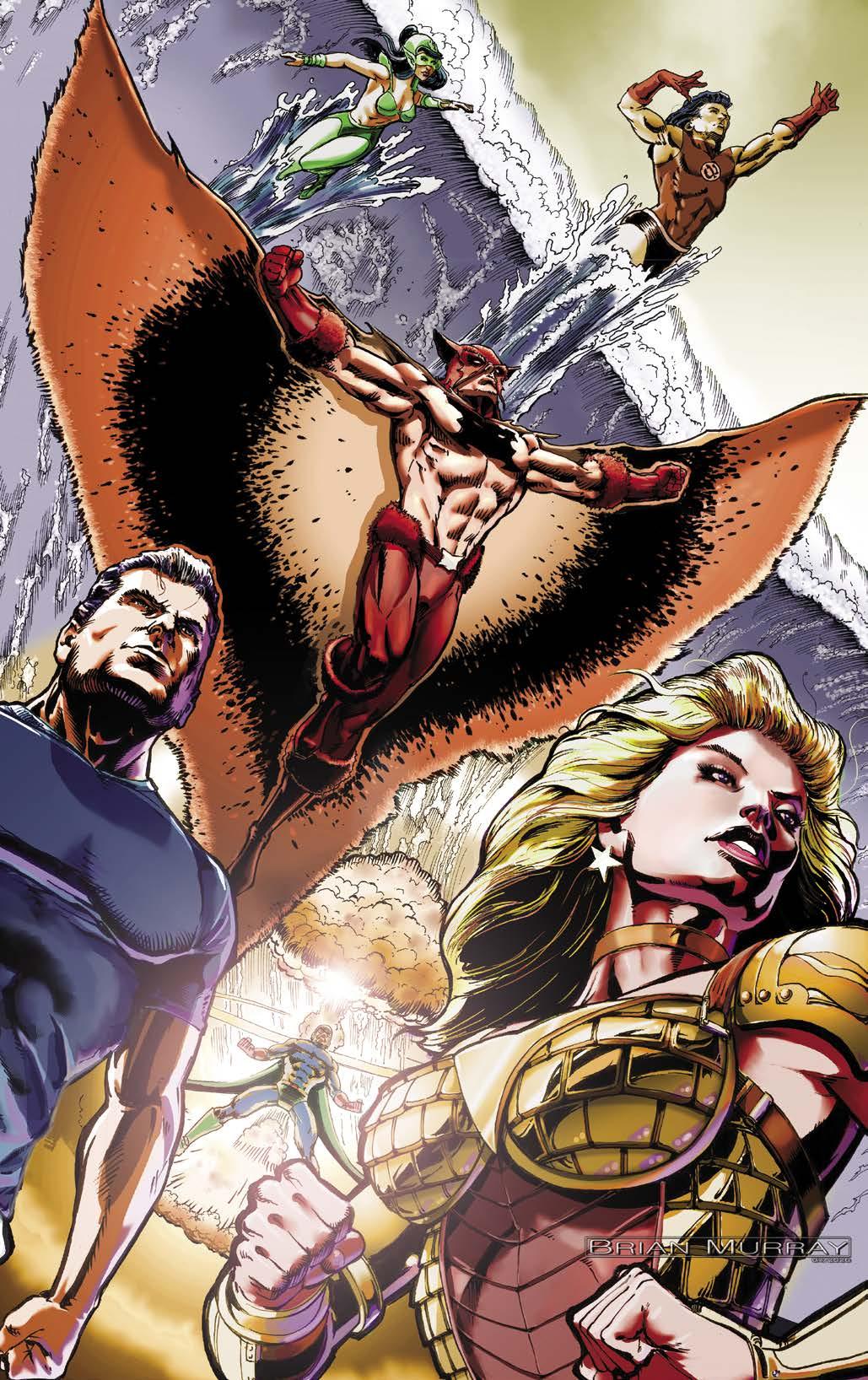
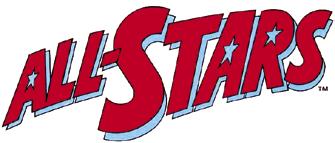
$10.95 In the USA No. 180 March 2023 1 8 2 6 5 8 0 0 4 7 3 6 Roy Thomas' All-Stellar Comics Fanzine Young All-Stars TM & © DC Comics; other art © Brian Murray. STARRING: (YOU SHOULD FORGIVE THE EXPRESSION) BRIAN MURRAY HOWARD SIMPSON LOU MANNA ROY THOMAS PLUS A COSMIC CORNUCOPIA OF NEVERPUBLISHED YOUNG ALL-STARS ART! TM CELESTIAL SPOTLIGHT ON TM
March 2023
Editor Roy Thomas
Associate Editor
Jim Amash
Design & Layout
Christopher Day
Consulting Editor
John Morrow
FCA Editor
P.C. Hamerlinck
Mark Lewis (Cover Coordinator)
Comic Crypt Editor
Michael T. Gilbert
Editorial Honor Roll
Jerry G. Bails (founder)
Ronn Foss, Biljo White
Mike Friedrich, Bill Schelly
Proofreaders
William J. Dowlding
David Baldy
Cover Artist & Colorist
Brian Murray
With Special Thanks to:
Heidi Amash
Pedro Angosto
Ger Apeldoorn
Richard J. Arndt
Bob Bailey
Mike W. Barr
Stephen Baskerville
John Benson
Bernie Bubnis
Mark Carlson-Ghost
Craig Cermak
John Cimino
Mike Collins
Comic Book Plus (website)
Kevin L. Cook
Chet Cox
Al Dellinges
Shane Foley
Brendon & Brian Fraim
Joe Frank Stephan A. Friedt
Susan Fujitani
Janet Gilbert
J.T. Go
Jared Gold
Grand Comics
Database (website)

Terry P. Gustafson
George Hagenauer
James Hall
Ron & Jan Harris
Heritage Art Auctions
Jim Hofrichter
Christopher Ivy
Gerard Jones
John Joshua Sharon Karibian
Jim Kealy
Rob Kirby
Johnny Blaze Leavitt
Art Lortie
Frank Lovece
Jim Ludwig
James E. Lyle
Mitch Maglio
Dan Makara
Dennis Mallonee
Lou Manna
Doug Martin
Ian Millsted
Gary Morgan Stanley Moss
Mark Muller
Mike Mulovsky
Brian Murray
Andrew Pepoy
Dann Phillips
Ian Richardson
Richard Rubenfeld
Randy Sargent
David Scroggy
Richard Seetoo
Rob Shalda
Sheep Meadow Press
Howard Siegel
Howard Simpson
Bryan Stroud
Dann Thomas
Shawn van Briesen
Delmo Walters, Jr.
John Watson
Ted White
Who’s Who of American Comic Books 1928-1999 (website)
This issue is dedicated to the memory of Frank Thorne, M. Thomas Inge, and Andy Yanchus
Contents
Writer/Editorial/Article: Forever Young?
. . . . . . . . . . . . . . . . . 2
Roy Thomas’ brief and biased history of DC’s The Young All-Stars (1987-89). Brian Murray—First Of The Young All-Stars . . . . . . . . . . . . . . 11 Richard Arndt interviews the original illustrator of the All-Star Squadron sequel series. “We’re All Fans!” . . . . . . . . . . . . . . . . . . . . . . . . . . . . . . . . . . . 22
An interview with early Young All-Stars artist Howard Simpson. Lou Manna & The Young All-Stars . . . . . . . . . . . . . . . . . . . . . 30 Candid conversations by R. Arndt & Mitch Maglio with the series’ final penciler.
The Young All-Stars: Crisis Averted! . . . . . . . . . . . . . . . . . . . 43
Johnny Blaze Leavitt’s artistic response to the end of Earth-Two.
The All-Star Squadron Covers That Never Were— Till Now! (Part II) . . . . . . . . . . . . . . . . . . . . . . . . . . . . . . . . . . 47
The counter-Crisis on Infinite Earths legend continues, courtesy of John Joshua & co. Mr . Monster’s Comic Crypt! Michael T . Gilbert’s 2023 Comic Art Portfolio . . . . . . . . . . . . . . . . . . . . . . . . . . . . 53
MTG’s colorful commission work—from Elric of Melniboné to The Spectre. Tributes To Frank Thorne, M . Thomas Inge, & Andy Yanchus . . . 61 re: [correspondence, comments, & corrections] . . . . . . . . . . 64
FCA [Fawcett Collectors Of America] #239 . . . . . . . . . . . . . . 71
The 1943 Fawcett career of critic Stanley Kauffmann, courtesy of P.C. Hamerlinck.
On Our Cover: While we were in the earliest stages of the preparation of this issue, lead-off Young All-Stars artist Brian Murray sent us a scan of this never-published color drawing he’d done of the teenage titans of World War II—and there was never any second choice for this edition’s cover! See its full story, step by step, on p. 17 of this issue. [Young All-Stars TM & © DC Comics.]
Above: “Iron” Munro may have been “able to leap tall buildings at a single bound,” but he couldn’t really fly like the aptly named Flying Fox could—so the pair’s Superman- and Batman-derived roles were momentarily reversed in this panel from The Young All-Stars #14 (July 1988). Script by Roy & Dann Thomas; pencils by Howard Simpson; inks by Malcolm Jones III . [TM & © DC Comics.]
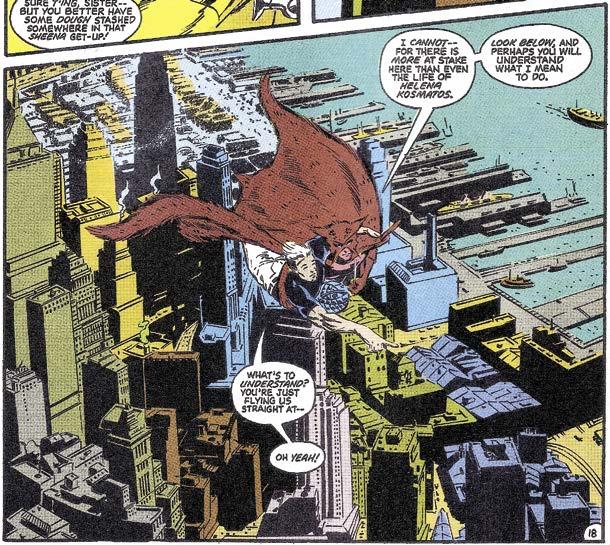
Alter Ego TM issue 180, March 2023 (ISSN 1932-6890) is published bi-monthly by TwoMorrows Publishing, 10407 Bedfordtown Drive, Raleigh, NC 27614, USA. Phone: (919) 449-0344. Periodicals postage paid at Raleigh, NC.
POSTMASTER: Send address changes to Alter Ego, c/o TwoMorrows, 10407 Bedfordtown Drive, Raleigh, NC 27614.
Roy Thomas, Editor. John Morrow, Publisher. Alter Ego Editorial Offices: 32 Bluebird Trail, St. Matthews, SC 29135, USA. Fax: (803) 826-6501; e-mail: roydann@ntinet.com. Send subscription funds to TwoMorrows, NOT to the editorial offices. Six-issue subscriptions: $73 US, $111 Elsewhere, $29 Digital Only. All characters are © their respective companies. All material ©their creators unless otherwise noted. All editorial matter © Roy Thomas. Alter Ego is a TM of Roy & Dann Thomas. FCA is a TM of P.C. Hamerlinck. Printed in China. FIRST PRINTING.
Vol. 3, No. 180
Forever YOUNG?
The Short Happy Life Of The Young All-Stars
by Roy Thomas
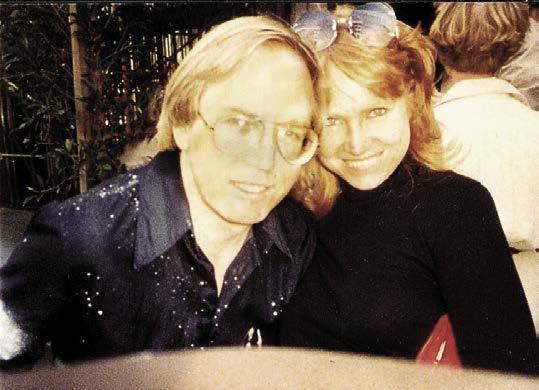
INTRODUCTION: Yeah, that’s right—no “writer/ editorial” per se this issue, as that space has been given over to this several-page study of the Young All-Stars series instead. When I decided to finally pull together an issue of A/E centered around “my” (and of course DC Comics’) 1987-89 series The Young All-Stars, the successor to the 1981-87 All-Star Squadron, I was faced with a minor dilemma. I’d already written a fairly full account of the backstory behind that mag for TwoMorrows Publishing’s 2008 tome The All-Star Companion, Vol. 3, as prelude to a 40-page issue-by-issue examination by Kurt Mitchell and myself. Unable to improve upon that several-page intro, I decided it was best to simply augment it slightly for this issue….


 A/E EDITOR’S
A/E EDITOR’S
In the letters section of the final issue of All-Star Squadron (#67, March-April 1987), I addressed the readers in my triple capacity as “writer/creative editor/co-creator.” In response to rampant rumors concerning a “second series” of Squadron as the first came to its end, I said that three months from that date would see the debut of The Young All-Stars. It would have a slightly different cast, yet would be in every way a successor to the series being discontinued.
“As everyone knows,” I wrote, in any post- Crisis on Infinite Earths comic set during the era of the Second World War, there would henceforth be no Superman, Batman, Robin, Wonder Woman, Aquaman, Green Arrow, or Speedy—“or any memory of
writer/editorial/article
Roy & Dann & Friends
PART ONE 2 TM
Roy & Dann Thomas in the 1980s equivalent of a selfie—and the house ad in the letters section of All-Star Squadron #67 (March-April 1987) that gave fans their first glimpse of the six assembled Young All-Stars who’d be holding forth in the brand new mag the Thomases would co-write just three months later. The illo below, previously credited to Michael Bair, was actually penciled by Brian Murray and embellished (as an inking sample) by Malcolm Jones III. [TM & © DC Comics.]
same” by anyone on DC’s spanking-new One Big Earth. That septet of heroes would be replaced there by “a smattering of new All-Stars—younger ones”—and those six were duly depicted at the bottom of that “All-Star Squadroom” page. Alert readers immediately recognized Neptune Perkins, Tsunami (Miya Shimada), and Dan (Dunbar) the Dyna-Mite, all of whom had appeared in Squadron at some point—and I revealed that the lady in the golden armor was the Golden Age Fury, “who seems to be the mother of Lyta Trevor of Infinity, Inc.” I had impishly decided to have a 1940s as well as a 1980s heroine named Fury, and indeed the new one’s backstory was only then going on sale in Secret Origins #12 (March ’87), as a harbinger of the forthcoming successor series.
As for the other two figures in the drawing, I coyly opined as how we needed to hold a few surprises back for The Young All-Stars #1. But I reminded readers of certain hints I’d laid out in previous letters sections about how the energy represented by the likes of the Earth-Two Superman, et al., displaced when they were rendered retroactively non-existent by the events of Crisis, had to go somewhere. (My theory, as would finally be revealed fully in YAS #3, was that that energy went into the likes of the two heroes “Iron” Munro and Flying Fox, while Wonder Woman’s was re-embodied in the new Fury. Of course, that hypothesis was stretched a bit by the fact that Neptune Perkins and Tsunami existed before Aquaman did not—and where did that leave GA and Speedy? Clearly, I just used that theory as a starting point.)
I did assure readers that the likes of Johnny Quick, Liberty Belle, Green Lantern, Hawkman, et al., would appear in the new series—although I pointedly did not tell them that the DC powersthat-be had decreed that I should use the “adult” All-Stars only sparingly.
What had happened was that, in November of ’85, DC executive editor Dick Giordano and I had talked over the looming situation post- Crisis and had agreed that All-Star Squadron had been fatally wounded by that company-wide maxi-series. I would have preferred to continue with the original comic featuring the heroes I had left—still dozens strong, after all—but I could read the handwriting on the wall, so I acquiesced to replacing Squadron with a new comic.
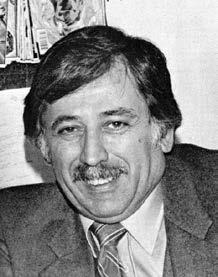
For a time, the new series was to be called simply The New All-Star Squadron, but that title lacked pizzazz. I felt strongly that the word “All-Star” should be a part of its name. It was apparently on an Amtrak train headed south from New York City to central South Carolina, where
my wife Dann’s father had moved from southern California to launch a new branch of Hughes Aircraft, that the name The Young All-Stars was born. The precise wording was Dann’s suggestion—and it was the perfect phrase. (The only previous super-hero group with the word “young” in its title had been Timely’s Young Allies, way back in the first half of the 1940s. But my Lord, how many Young Avengers,Young Justice, Young Etc. gatherings there’ve been since!)
From that point, Dann and I had begun creating the new heroes, “whose history and futures are largely unknown—a few blank slates to write upon.”
Wonder Woman needed replacing because somebody had to become the future mother of Lyta (Fury) Trevor of Infinity, Inc. After talking with Dick and with George Pérez, who was then making considerable use of Graeco-Roman myth in his new Wonder Woman series, Dann and I decided, with their blessing, that she and I would “just carve off one little corner [of mythology] for our new heroine—the three Furies of Greek legend.” And so Helena Kosmatos became the “original” super-heroine called Fury.
I had considered not doing “displaced energy stand-ins” for Batman and Robin, since they had no super-powers—till I remembered that Jerry Bails’ 1970s publication Who’s Who of American Comic Books had reprinted a panel featuring an early DC aviator hero called The Flying Fox; he had appeared in eight 1939 issues of More Fun Comics. That’s actually the name of a species of bat—or at least it had been considered so until recent years, when scientists had decided it was actually not a bat but a small primate.
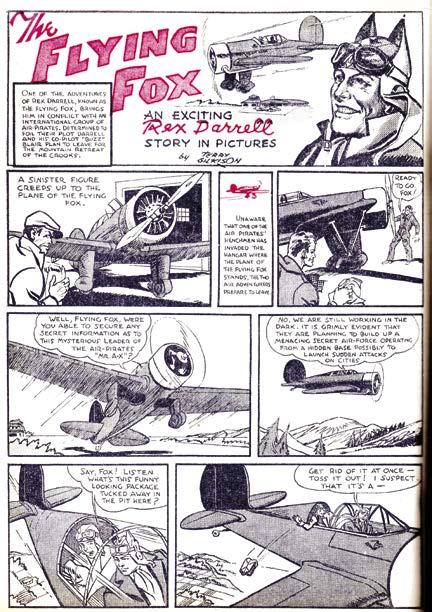
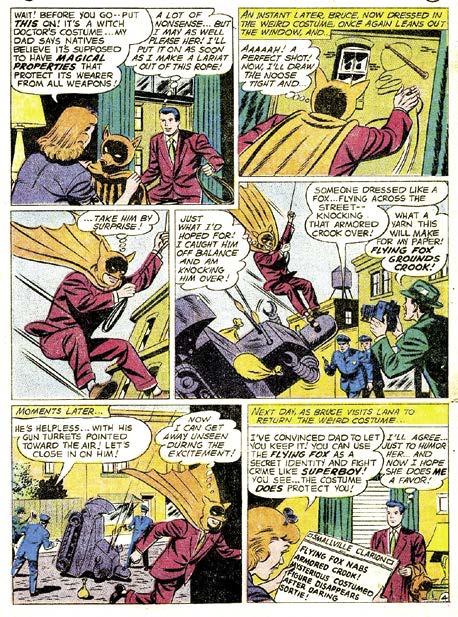
Forever Young? 3
Dick Giordano
A popular artist in his own right, but especially celebrated as the inker of Neal Adams and others, DG was also DC’s managing (then executive) editor from 1981 to 1993.
Smart Like A (Flying) Fox Two DC Flying Foxes before the one in Young All-Stars: writer/artist Terry Gilkison’s aviator in More Fun Comics #46 (Aug. 1939)—and a very young Bruce Wayne adopting a temporary secret identity while visiting Clark Kent’s Smallville in Adventure Comics #275 (Aug. 1960). “Superboy” script by Jerry Coleman & art by George Papp. Thanks to Mark Muller. [TM & © DC Comics.]
BRIAN MURRAY— First Of The Young All-Stars
INTERVIEWER’S INTRODUCTION: Brian
Murray was the artist finally brought on to draw most of The Young All-Stars #1… and became the series’ lead artist. Brian has also worked on such series as DNAgents, The Badger, Ms. Mystic, Youngblood, Shadowhawk, Rune, and Batman. In addition, he was the original penciler for Supreme, working with writerinker Rob Liefeld. This interview took place on September 3, 2022.
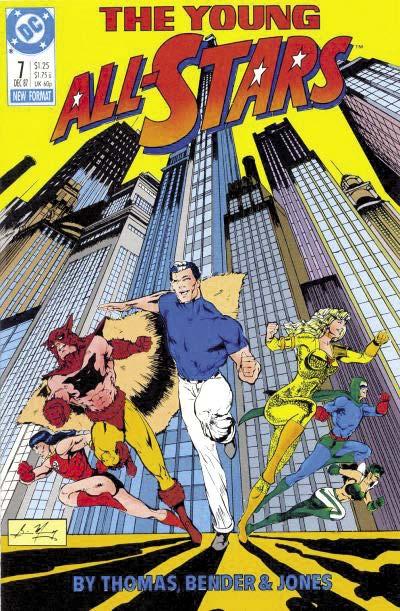

RICHARD ARNDT: Looking at your credits, Brian, I noticed that The Young All-Stars was one of your first professional bylines. You had done a story for Continuity, which was Neal Adams’ publishing company, and you’d done a full issue for Eclipse’s The New DNAgents, but The Young All-Stars was your first regular gig.
BRIAN MURRAY: Wow, I’d forgotten all about that DNAgents story. You may know more about my history than I do. [both laugh]
RA: For the sake of the interview, I hope not! I have a note here that says you worked on The Young All-Stars #1-10 and perhaps on an annual. But you didn’t do full issues, for the most part. You were often doing the penciling of half an issue. Is that right?
MURRAY: Yes, a couple of them I did full issues… but you’re right, for the most part I did pencils for half of the contents of each issue. The work on the annual was really just pin-ups included in the storyline.
RA: I assume this was because of the deadlines on a monthly title, combined with you just getting into the industry.
“Iron”
Dyna-Mite,
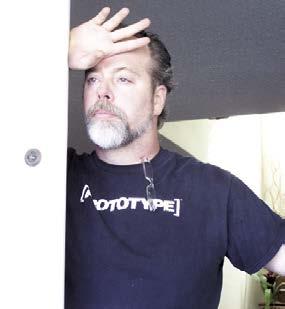
#7 (Dec.
In response to our request, Brian sent this brief bio: “Born on Long Island, New York, Brian “Adobewan”
where he’s resided
MURRAY: Young All-Stars was very labor-intensive. First, I tended to work representationally rather than cartoony, so there was more labor involved. There were also a ton of characters! Each issue had the group of young super-heroes, plus the group of villains they were fighting, and Roy liked to have all the characters within the frame as much as possible.

RA: I’ve taken a look at some of those pages, and many members of the Justice Society and All-Star Squadron and Seven Soldiers of Victory also appeared fairly frequently. There were a lot of characters to draw.
I guess we should discuss how you came to the attention of Roy Thomas, who was the editor who would have asked for you, I would think. I know he had assistant editors as well, so perhaps they might have been the original contact point. [NOTE: See Roy’s account back on p. 5.]
MURRAY: That’s a good question. How did that come about? If I’m remembering correctly, I was working for the DIC animation company. It was a rather low-rent organization. When I was
younger, I was voracious about sending my work around. I sent stuff out to everyone. Anybody who had anything to do with comics, I was going to send work to. I remember sending a packet of art to Gary Groth, the publisher of The Comics Journal, which, at the time, was probably the biggest magazine dealing with the history of comics. I was young and stupid, but his reaction was classic, weird, and funny. He mailed it back, unopened, with a big question mark on the envelope.
RA: [laughs] O.K.
MURRAY: I’m going to guess that Roy was one of the people I reached out to. Roy may actually remember this better than I do.
RA: I’m looking at your artwork on the cover of The Young All-Stars #1 and it’s quite attractive. I’m sure you’ve greatly improved since then, but the cover is quite good. [NOTE: See p. 13.]
PART TWO 11 TM
Interview Conducted & Transcribed by Richard J. Arndt
Brian Murray in what he terms a “self-portrait photo” from a few years back— and his first cover for The Young All-Stars that depicted all six of the original cast: Neptune Perkins, Flying Fox,
Munro, Fury,
and Tsunami. A nice piece of composition for YAS
1987). Thanks to the artist and the GCD, respectively. [TM & © DC Comics.]
Murray moved to Southern California at age 20,
since. His career started in comicbooks, crossed over to Saturday morning animation… he spent a number of years as an Advertising Art Director, produced a series of skateboard decks for Tony Hawk, and finally, using Photoshop, ZBrush, and a vast array of digital tools, he landed as a concept story artist for film, TV, and video games, working on projects such as Ready Player One, Star Trek: Picard, Mortal Kombat 12, and Spider-Man: Far from Home, for directors like Stephen Spielberg, Ron Howard, and Martin Campbell.”
RA: Which one of the Young All-Stars characters was your favorite?
MURRAY: Flying Fox, followed closely by “Iron” Munro. One of the coolest things about working on this book for me was working with Roy. It was the Kree-Skrull War sequence in The Avengers that he wrote and Neal Adams illustrated that was the reason I wanted to become a comicbook artist. Neal’s art, especially on the issue where Ant-Man traveled into The Vision’s body, I remember very well. It was while in the moment of reading that story that I realized that comics was what I wanted to do.
I like Flying Fox not only because he was a great character but because his costume was my design, so it was easy for me to draw. I just loved that.
RA: You avoided Joe Kubert’s problems with the 1940s Hawkman helmet. [chuckles]
MURRAY: I loved Joe Kubert’s work and, as I grew older, had a greater appreciation for his work. I have an original Sgt. Rock of his that I see every day as I walk up my stairs. He did, however, have a problem with the Hawkman helmet in the 1940s. It was never drawn to fit his head properly.
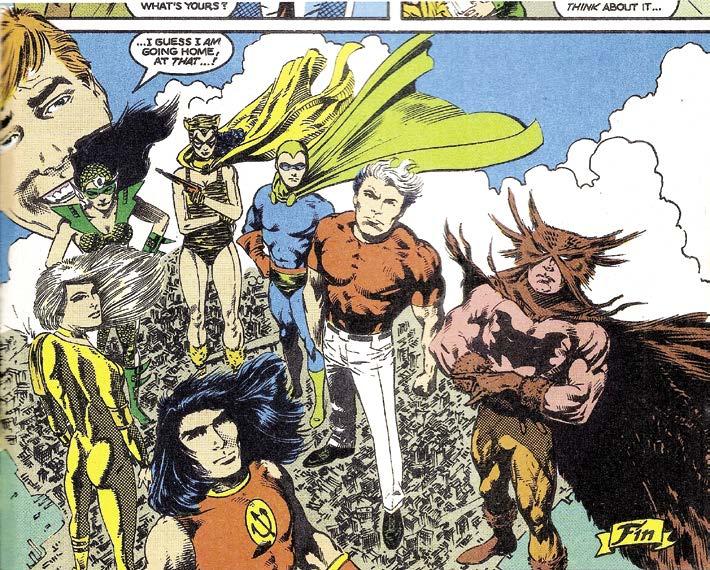
RA: Yes, and he admitted it. That’s why he changed it to the generic yellow mask. When he revived the character in the 1960s, he drew a hawk helmet again, but initially it didn’t have the wings. They were added a bit later to complete the look.
MURRAY: When it’s done well, that Hawkman helmet, with the wings, is one of the coolest costumes ever. I don’t know if you’ve seen the trailers for the upcoming Black Adam film, but there’s a moment when you see Hawkman and he spreads his wings out. Now, the wings themselves are changed to metal wings, but Holy Crap! He looks rad! The one moment really shows what a cool character he is, visually.
RA: He really was a cool-looking character, and when you tried to simplify the look of the helmet, he simply wasn’t.
MURRAY: Yes, I agree.
Part of what I loved about working on Young All-Stars was that
“Iron”
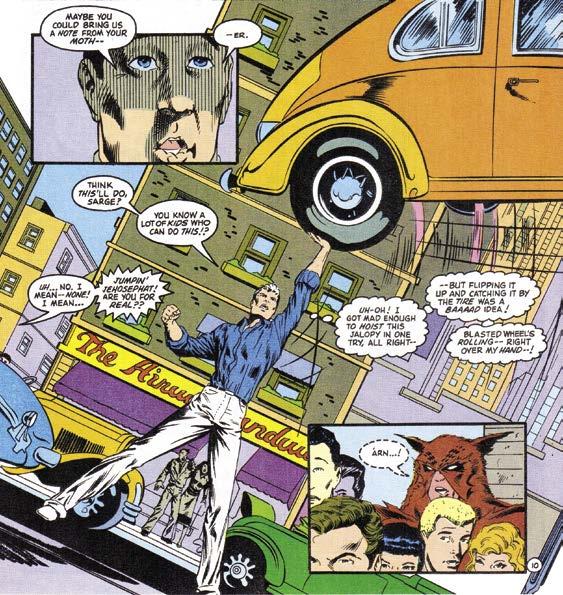
Arn [“Iron” Munro] and Flying Fox were the analogs for Superman and Batman. I loved those characters.
“Iron” Munro was the son of the Gladiator, a character created by Philip Wylie in a 1930 novel called Gladiator, who influenced the development of Superman. Roy, and I think Tony De Zuniga, adapted that novel as “Man-God” for Marvel Preview #9 [Winter 1976] for Marvel. De Zuniga did a fantastic job on the artwork for that book. Roy and I covered parts of the origin of Wylie’s original character, Hugo Danner, in Young All-Stars #10-11 [Feb.-Mar. 1988]. And Wylie’s character Hugo Danner is “Iron’s” father. [A/E EDITOR’S NOTE: Actually, though not credited properly, Rich Buckler penciled the Marvel adaptation of the first half of the never-finished Gladiator adaptation; DeZuniga was the inker/embellisher.]
RA: Were most of The Young All-Stars original characters?
MURRAY: Half were, and half were not. Neptune Perkins, Dyna-Mite, and Tsunami had already been introduced in different books before #1, but “Iron” Munro, Flying Fox, and Fury were original to the book. Fury, I think, was designed by Michael Bair. I did the designs for Flying Fox and “Iron” Munro.
A Place In The Sun
15
Series
The Original Main Illustrator Of The All-Star Squadron Sequel
Again With The Cars!
Munro hoists a WWII-era automobile in Young All-Stars #5 (Oct. ’87), courtesy of penciler Brian Murray and inker Malcolm Jones III. Script by Roy & Dann Thomas. Thanks to Jim Kealy. [TM & © DC Comics.]
The final panel of the “Dan the Dyna-Mite” backup story in 1988’s Young All-Stars Annual #1-and-only. Full art by Malcolm Jones III; script by Roy & Dann Thomas. [TM & © DC Comics.]
“We’re All Fans!” An Interview with Young All-Stars Artist HOWARD SIMPSON
Conducted & Transcribed by Richard J. Arndt

NTERVIEWER’S INTRODUCTION: Howard Simpson made his comics debut on Green Lantern #169 (Oct. 1983), penciling a framing sequence. He also worked on such titles as The Outsiders, Secret Origins, The Young All-Stars, Who’s Who, Showcase ’95 for DC; Flare, Captain Thunder and Blue Bolt, Icicle, and League of Champions for Heroic Publishing; Solar - Man of the Atom, X-O Manowar, Eternal Warrior, Harbringer, Ninjak, Psi-Lords, and Turok, Dinosaur Hunter for Acclaim/Valiant; Deathmate for Image; Grimjack and Munden’s Bar for First Comics; The Ray Bradbury Chronicles for Topps; Blaze: Legacy of Blood and Ghost Rider for Marvel; as well as long runs on such titles as Looney Tunes and Simpson Comics. This interview took place on April 18, 2021.
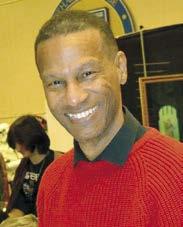
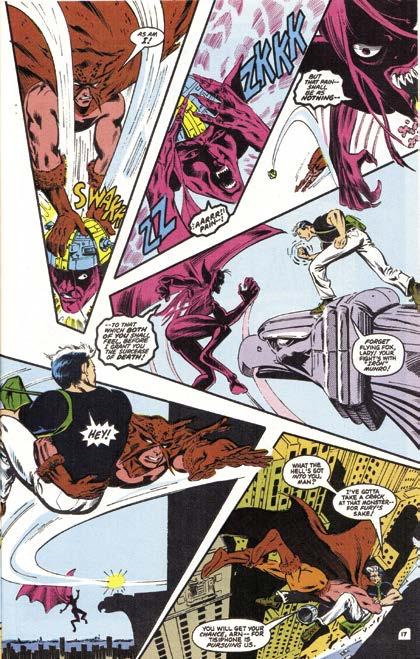

RICHARD ARNDT: Thanks for agreeing to this interview, Howard. Was The Young All-Stars #3 (Aug. 1987) your first major work in comics?
HOWARD SIMPSON: Actually, it was my second job, but I guess it was my first full book. The first job was a “Green Lantern Corps” story. That would have been in the Green Lantern comic. That story was about a Green Lantern that no one had ever heard of and hasn’t heard from since!
Not surprising, I guess, since there’s supposed to be 4,000 of them across a pretty big galaxy. That’s what the back series was supposed to do—give the reader an idea of how many Lanterns there were out there, besides just the ones from Earth.
RA: I suspect those back-ups were also used in the same way the DC mystery books were used, to give young artists a chance to do a complete short story and not have to jump feet-first into a full-length monthly title. To show off their chops before dealing with anything bigger.
SIMPSON: Yeah, definitely. When I started, Joe Orlando was still the editor there, and he was going to give me a story to do. Joe was all about helping out new talent, giving them a place to develop professionalism. Unfortunately, that was the only story I did for him before he retired from DC in 1996.
RA: Did you work as an assistant for anyone before you began doing your own solo work?
SIMPSON: I tried to be an assistant to Ernie Colón, but just about that time, he stopped using assistants. However, he did do some mentoring of me. Then I joined a DC Talent program that Dick Giordano started with another person, who was to be the head of that. Ernie Colón took over the program very shortly thereafter. Since I’d previously known Ernie, that was a good thing. Then, when Ernie became an actual DC editor, he was very helpful to me.
RA: DC Talent. Is that when they were doing the DC Talent Showcase book?
SIMPSON: No, no, this was quite a while before that. This was the very first New Talent program. This was in the 1980s—1981 or ’82.
The Showcase version came out in the mid-’90s. If any of the DC editors wanted to use any of us from that program, well, that was the whole purpose of the program, but it didn’t happen much. It actually became very frustrating in how it actually was practiced.
RA: So, kind of a blind alley for artists?
SIMPSON: Right. Looking back, my second story wasn’t the Young All-Stars story but rather a “Dr. Occult” story that I did for Roy Thomas’ Secret Origins. Working with Roy on that title was how he got to know of me and how I got the Young All-Stars job. I was sitting up at DC offices, talking with a bunch of other freelancers, when Greg Weisman—who was the assistant editor of Secret Origins at that time—popped his head out the door into the hallway and asked me, “Hey, didn’t you show me some work about magic apples?” I said yes and he said, “Come here.” I went into his office and it turned out that one of the artists assigned to draw the “Dr. Occult” story had gotten sick, and because I’d showed him a sample page dealing with magic, I got the “Dr. Occult” assignment. It was just pure luck that I was sitting in the office at the time.
RA: Lucky you! There’s a pretty big gap between the “Green Lantern” story and the “Dr. Occult” story, though…
SIMPSON: I was actually still in college—the Tyler School of Arts—when I got the “Green Lantern” story. I was also under the false impression that once I got one story I would be hired for more. That didn’t happen for a long time. Four years, in fact. In college, I had been pushing myself, looking for work and meeting up with editors, showing them my samples, before the “Green Lantern” story and that impression—that false impression—that getting one job would open the door to more jobs—took hold of me for a while. Once I graduated and realized that I still needed to push myself, I
PART THREE 22 TM
Howard Simpson at a con in Ithaca, NY—juxtaposed with a page he penciled of “Iron” Munro and Flying Fox battling Tisiphone, the Greek mythological entity Fury who had taken over the body of the human Helena Kosmatos in Young All-Stars #14 (July 1988). Inks by Malcolm Jones III; script by Roy & Dann Thomas. Thanks to Sharon Karibian. [TM & © DC Comics.]
I
Rotten To The Corps?
started meeting up with editors again on a regular basis. My philosophy eventually became: “The first story is easy. The hardest one to bring about is the second job.” [laughs] Because any editor will give you a chance, but you’ve got to be impressive on that first job, for them to take a second look at you.
I think because of my association with the New Talent program, nobody was really looking for new artists.
RA: You also did a lot of drawings for the Who’s Who books around this time.
SIMPSON: Yes, I was doing a lot of the characters from Young All-Stars, so that job and working on Young All-Stars all came about at the same time.
RA: Did doing those Who’s Who pieces lead into The Young All-Stars or was it
Greg Weisman
Since his stint on Young All-Stars, et al., as coordinating editor (Wikipedia says “editor,” but that’s not quite correct), Greg has gone on to a stellar career in animation, and has also written several novels.
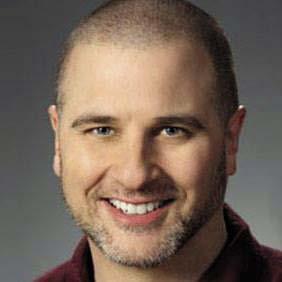
Internet photo provided by John Cimino.
the other way around?
SIMPSON: Greg Weisman was the editor on Who’s Who as well, so I was basically still working for him on those pin-up pieces. Greg was really my “in” for a lot of this work. I also did the pin-ups for the All-Star Squadron in those issues. Roy told me that DC had bought the rights to a lot of old 1940s heroes from companies that weren’t around anymore. DC had the rights at the time to the Quality characters, maybe some other companies like Fawcett or Charlton. Roy gave me a list and right away I noticed that some of the Quality characters were missing from the list. I called Roy and asked if I could include them, and he said yes.
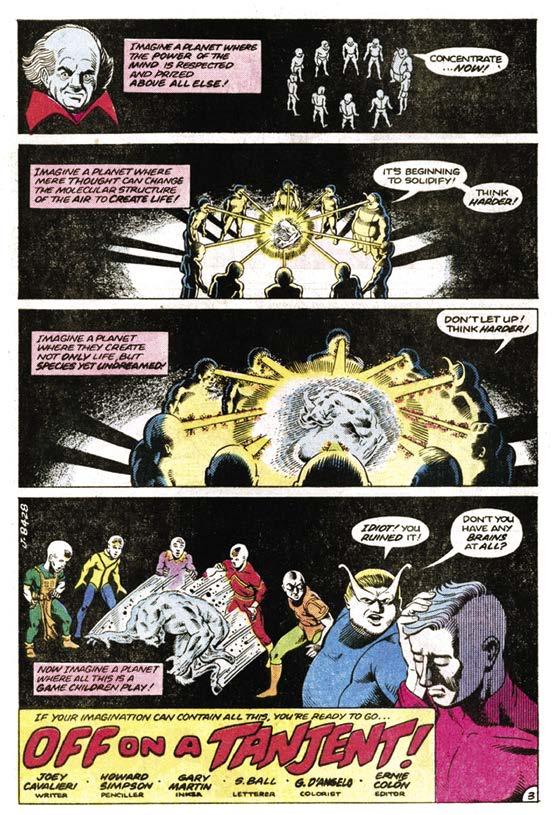
I wanted to include those characters like the Justice League had done in the early days. Head shots that were often lined up on the left side of the cover. I wanted to be sure that all the characters would be able to be identified, because in a big scene—maybe on a two-page spread—the reader wouldn’t necessarily know who all those characters were. I did one pass on the heads and, remember,
Howard
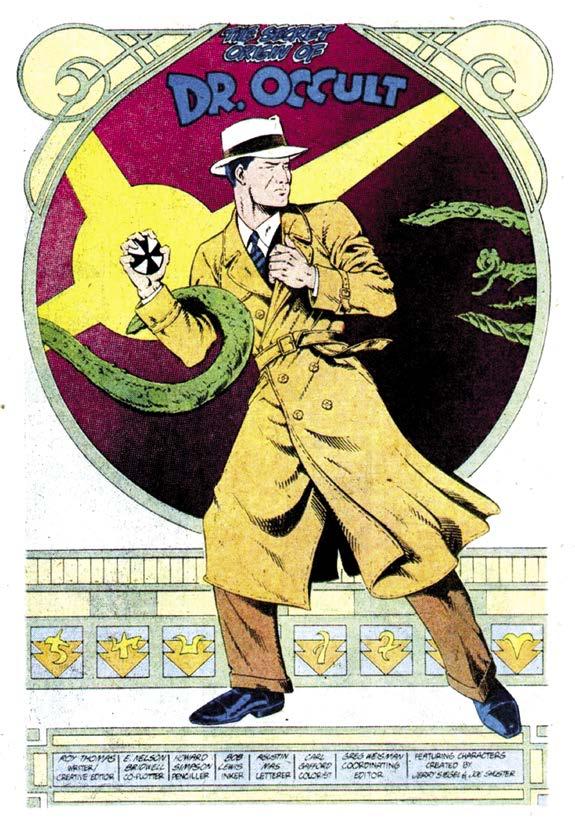
second job in
Origins #17 (Aug. 1987),
was
“Dr. Occult”
23 “We’re All Fans!”
Splash page of the lead story from Green Lantern #169 (Oct. 1983). Script by Joey Cavalieri, pencils by Howard Simpson, inks by Gary Martin. Thanks to Jim Kealy & Jim Ludwig. [TM & © DC Comics.]
The Doctor Is In—But Also Pretty Far-Out!
says his
comics
penciling the
story for Secret
which was inked by Bob Lewis. He got the assignment after the title’s NYC coordinating editor Greg Weisman suggested him to Roy Thomas. Script by RT (co-plotted by E. Nelson Bridwell); inspired by the late-1930s series by “Superman” creators Jerry Siegel & Joe Shuster. Roy loved the vintage feel Howard gave the art, which soon led to his working on The Young All-Stars. Thanks to Sharon Karibian. [TM & © DC Comics.]
LOU MANNA & The Young All-Stars

Two Candid Conversations With The Series’ Final Penciler
Interview #1 The Lost World
 Conducted & Transcribed by Richard J. Arndt
Conducted & Transcribed by Richard J. Arndt
INTERVIEWER’S INTRODUCTION: Lou Manna started his comics career as an assistant to artist Jim Janes on DC Comics’ The Legion of Super-Heroes, afterward assisting penciler Rich Buckler on such Marvel and DC titles as What If?, All-Star Squadron, and World’s Finest Comics. He graduated to his own work on J.C. Publishing’s early1980s revival of T.H.U.N.D.E.R. Agents. Over the years he’s worked for Archie, DC, Marvel, Heroic Publishing, Fictioneer Books, Conquest Press, Moonstone, and Alias, among others. He recently illustrated two true-life
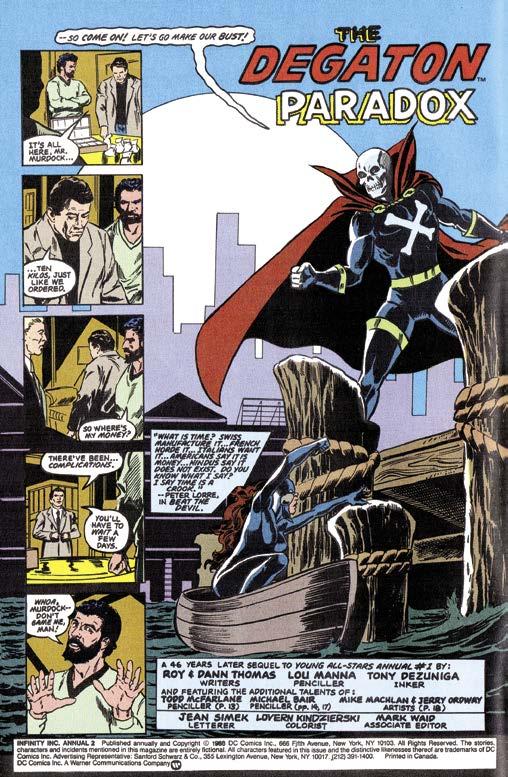

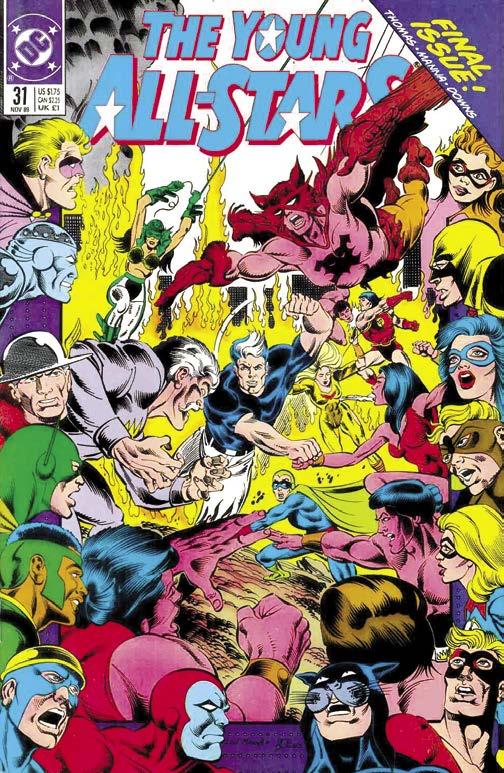
PART FOUR 30 TM
Lou Manna
above the title splash he penciled for Infinity, Inc. Annual #2 (1988) and his cover for The Young All-Stars #31 (Nov. 1989), the comic’s final issue. Inks by Tony DeZuniga and Bob Downs, respectively. Thanks to John Joshua and the Grand Comics Database, also respectively. In the Annual, Todd McFarlane, Michael Bair, and the team of Jerry Ordway & Mike Machlan accounted for four of its 40-page lead story’s pages, but Lou’s penciling 36 pages was still a formidable accomplishment under time pressure, especially for a relative newcomer. He says its first few pages were composed of his “Black Terror” sample pages, slightly redrawn—which makes it likely that Roy and Dann came up with much of the plot for that Annual to accommodate them. Very fitting, since Roy, when he drew the original concept sketch of the skullfaced Mr. Bones, had used the Golden Age Black Terror’s general look as a template, crossbones chest symbol and all. [TM & © DC Comics.]
It was great training—taught me how to lay out a page so it didn’t look crowded. I was really happy working on that book. We had a little studio with Janes and Rich Buckler. A lot of other guys dropped in from time to time. I ended up working with Rich as his assistant as well, on books like All-Star Squadron and What If? Rich was doing a lot of comics at the time and we were pretty busy. That studio work got me my first solo gig on T.H.U.N.D.E.R. Agents; this was the first revival of them, in the early 1980s. Chris Adames was the scripter, but we were both plotting the stories. Mark Texeira and Pat Gabriele were doing the inking. That was for the black-&-white issue [JCP Features the T.H.U.N.D.E.R. Agents #1 (Dec. 1981)]. For the color book we had Willie Blyberg inking, who had kind of a Wally Wood vibe. I thought he did a great job, particularly with the first issue. We got two color issues out, plus the black-&-white. Then we all left, and the revival kind of fell by the wayside.
For a few years after that, I had a job with the US Navy Resale as a creative services manager. It was a government job, and I had the time to work up some comics stuff on the side. I did a “Black Terror” story on spec. The Black Terror was out of copyright, so anybody could and, for that matter, still can use him in a story. I was also working in a comicbook store, and another artist came in
What If… Lou Manna Had Drawn An All-Star Squadron Cover?
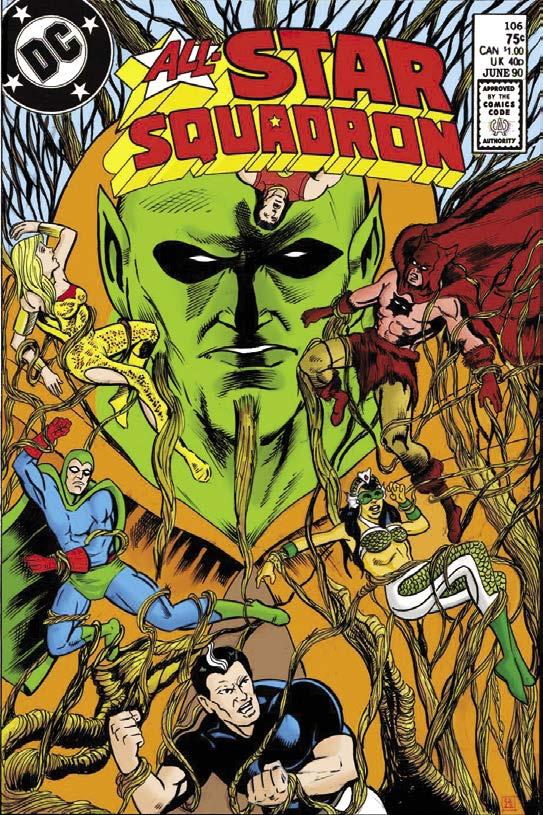
The Sound Of T.H.U.N.D.E.R.
and said, “Why don’t you send that stuff in to Roy Thomas?” Well, I wasn’t sure, and I hemmed and hawed. Then I said, “Give me his address.” and I mailed out those “Black Terror” samples to him.
If you get the second Infinity, Inc. Annual, the first five or six pages are redrawn versions of the “Black Terror” samples. I got a phone call out of the clear blue sky from Roy asking me what I was working on. I couldn’t believe it was actually Roy Thomas. He wasn’t just a writer. He was a famous writer. I told him what I was up to, and he said he’d like me to draw the Infinity, Inc. Annual, if I had the time. I told him sure, and he said he’d ship the script to me the next day. I was so excited. I still remember getting off the phone and being on Cloud 9, because I hadn’t been in the business for a while, wasn’t getting that much work, and here was a chance to work on a really nice DC book. I did the whole 40 pages of that story in a couple of weeks. I spent every spare minute working on it. Tony DeZuniga and Jerry Ordway did a nice job inking it.
It was a big deal. I think DC was only doing 32 titles at the time
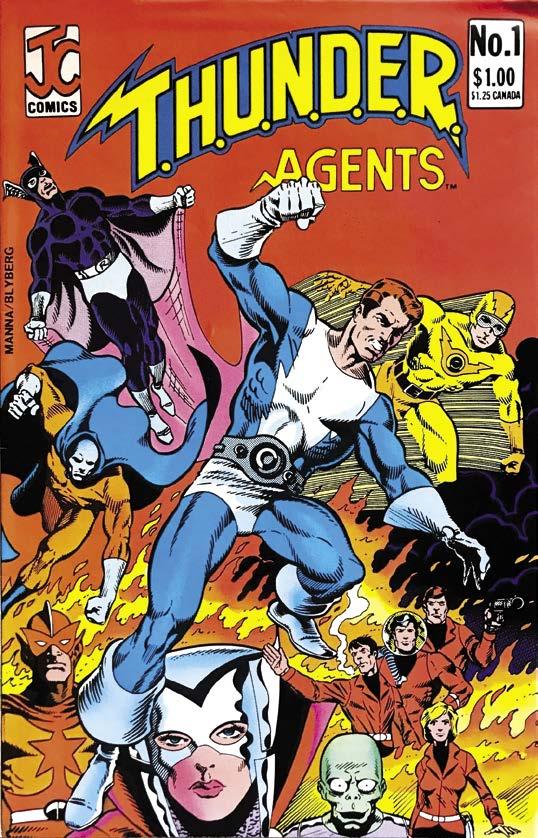
32 Two Candid Conversations With The Series’ Final Penciler
Lou penciled the cover for the first issue of the T.H.U.N.D.E.R. Agents revival from JC Comics, cover-dated August 1983. Inks by Willie Blyberg. Thanks to the GCD. [TM & © John Carbonaro.]
Since there’s no way to tell on which pages Lou Manna “assisted” in either Jimmy Janes’ Legion of Super-Heroes or the early Rich Buckler All-Star Squadron, here’s the faux cover of the latter that Lou penciled and inked for John Joshua’s ambitious project covered in A/E #175 and on pp. 47-51 of this issue. John had our interviewee depict The Young All-Stars battling Ramulus, a.k.a. Simon & Kirby’s creation Nightshade on “#106.” Colors by Rich Seetoo; courtesy of Lou & John Joshua. [TM & © DC Comics.]
and getting the opportunity to draw one of those… it was just a big deal. That was nice.
RA: Now, as Roy described it to me, you worked with him on four issues of Young All-Stars
MANNA: Yes. I actually started with Roy on Infinity, Inc.—a few pages in #50, I think, and then #51, and then the 40-page Annual Then Roy moved me over to Young All-Stars. I think he actually told me he was moving me over because Young All-Stars was supposed to last a lot longer than Infinity Inc. Then, as I was halfway through penciling the first issue [#28], I got a call from Roy, telling me that Young All-Stars was also being canceled after the current storyline. I never got a chance to really show what I could do in the long run, as I only drew the last four issues. [laughs]
Years later, I was having lunch with Dick Giordano and he told me, “If I knew you were on that book, I’d have kept it going.” [laughs] I mean, he was the managing editor—he should have known everything that was going on with all the books. But, you know, he was the kind of managing editor who let the editors under him run their own show, pretty much. I don’t think he interfered that much with the daily work that the editor was supposed to be
doing. He let them do what they had to do.
Dick did look after me. He tried to find me work. My personal wish was that there had been another ten issues of Young All-Stars. I think that would have established me on a steady book.
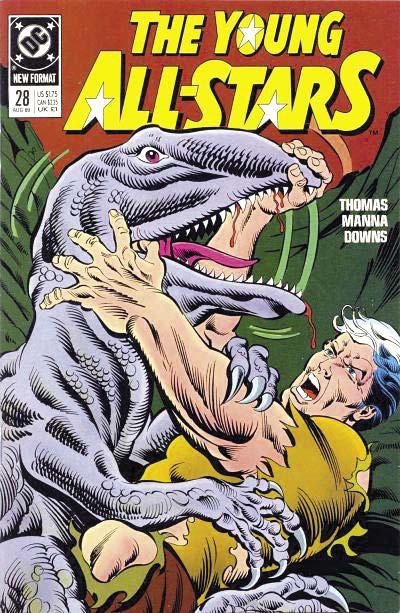
Young All-Stars was set in the 1940s and featured characters from that time period—Neptune Perkins, Dan the Dyna-Mite, Tsunami, Flying Fox, Fury, and “Iron” Munro. Roy wasn’t allowed to use the main DC 1940s characters—Superman, Batman, Wonder Woman, those guys—so he created these characters. Not all of them, of course. But I think they all had a link to the original Justice Society. The main character, “Iron” Munro, was based on the character from Philip Wylie’s 1930 novel Gladiator
RA: Right. Theodore Sturgeon wrote some of the 1940s “Iron Munro” stories, which came out from Street & Smith.
MANNA: Yeah. The Flying Fox was based on Hawkman. Fury was based on Wonder Woman. They were all variations on the original DC characters he couldn’t use. There was a character, Georgia Challenger, who was based on Professor Challenger from the Arthur Conan Doyle novel The Lost World. [A/E EDITOR’S NOTE: Sorry, but see pp. 3-4 for the actual origins of Flying Fox, which had
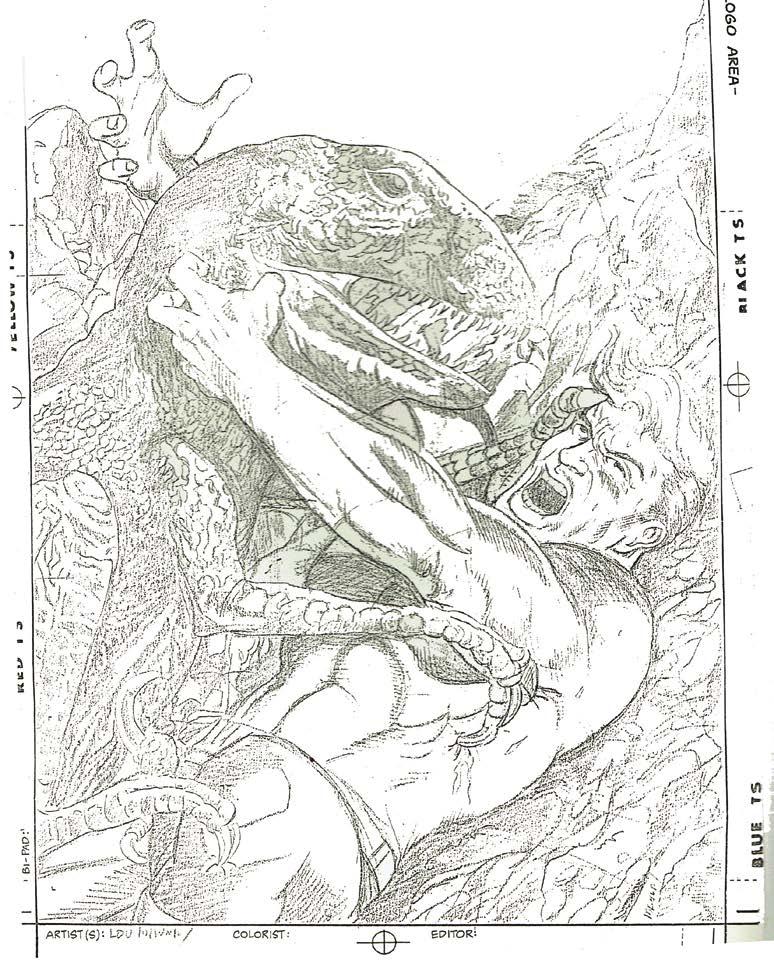
“There
With apologies to a poetic line from Lord Byron, who wrote “rapture.” Oddly, Lou’s penciled version of the cover of YAS #28 (on the right) seems more polished than the printed version (above) which was inked by Bob Downs. Thanks to Lou Manna & the GCD, respectively. Besides predating both novel and film versions of Jurassic Park in the use of a velociraptor, this wasn’t Roy’s first comicbook rodeo with that prehistoric reptile; see Marvel’s Conan the Barbarian #95 (Feb. 1979). Roy decided to stick one as well into this four-part storyline that was a DC Comics sequel of sorts to Arthur Conan Doyle’s 1912 novel The Lost World, which postulated an antediluvian world atop a mesa amid the South American jungles. Conan Doyle had to content himself primarily to iguanodons, some of the earliest dinosaurs to be unearthed. [TM & © DC Comics.]
33 Lou Manna & The Young All-Stars
Is A Raptor On The Lonely Shore”
Interview #2 King Of The Werewolf Western
Conducted & Transcribed by Mitch Maglio
MITCH MAGLIO: How did you get your start in comics?
LOU MANNA: I started assisting an artist named Jimmy Janes in 1979. Actually, the first thing I ever did was “The Rook” for Warren, which they revived recently—and then “The Legion of SuperHeroes” with him. When he did that, I laid out the issues from the scripts. I would take the script, break it down for him, then he would take it fix it and correct it. We did that for about a year.
So, in 1975 I started going up to DC. In ’79 I started working with Jimmy, and then I went to DC one day, and I showed my
samples as usual. While Dave Manek and Dick Giordano were on the phone, I picked up my samples and left and went home. When I got home, there was a call: “Where’d you go? We were looking for you. We wanted to give you work.”
I said I was so used to getting rejected I just assumed I was [rejected] again. And that’s the first thing I got from DC on my own—and it was a werewolf Western! It was good training. Dick Giordano and Dave Manek were the editors. They were encouraging to me, and from that point on for about a year and a half straight I got House of Mystery stuff… six-page, eight-page stories. It was good training, because it made you draw things you didn’t want to… like werewolves, Westerns, and mysteries.
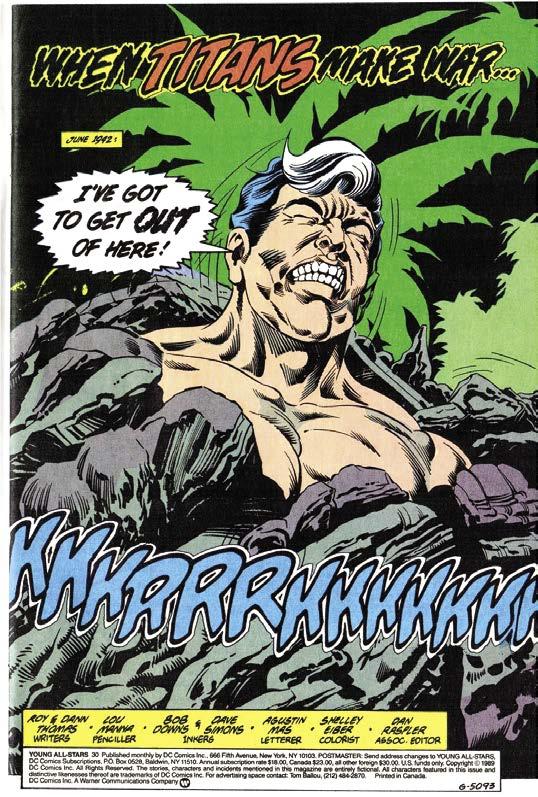
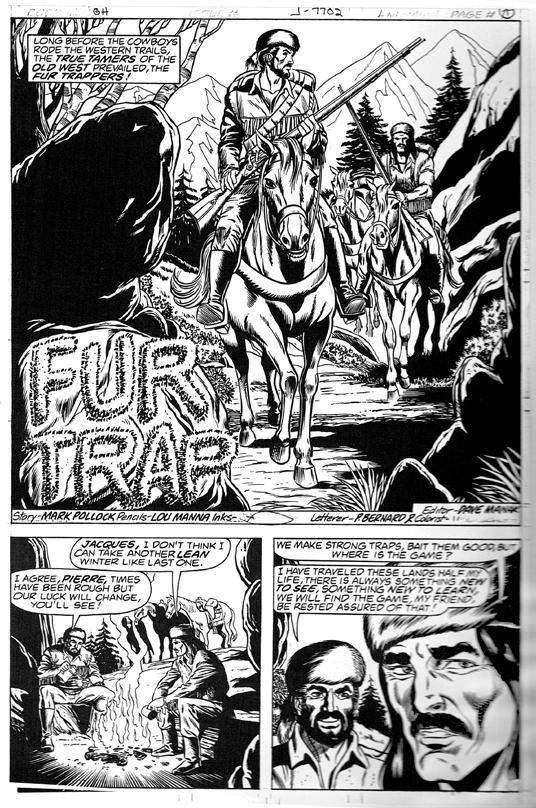
When I was trying to break in, my uncle knew [artist] John Celardo from Port Richmond [High School], I guess. I went to see John Celardo, and he was trying to be diplomatic at the time and said, “It would make a nice hobby, I guess. Think of it as a hobby.” And then, two or three months later, he was inking one of my stories! One of my mystery stories for DC.
I had a lot of old-time inkers—Tex Blaisdel, John Celardo, Sal
38 Two Candid Conversations With The Series’ Final Penciler
From “Werewolf Western” To The Lost World
(Left:) An image of the original art for the splash page of the story Lou penciled for one of DC’s “mystery” comics in the early 1980s, which was inked by Sam Grainger and written by Mark Pollock. We couldn’t find any listing on the GCD of a story called “Fur Trap,” so either the title was changed (and the GCD didn’t catch it under its new name, either), or else that yarn was never published… though Lou did have at least one story published in House of Mystery (#306). [TM & © DC Comics.]
(Right:) “Iron” Munro struggles in vain to escape from a huge hunk of fused rock, in Young All-Stars #30 (Oct. 1989). Script by Roy & Dann Thomas; pencils by Lou Manna; inks by Bob Downs & Dave Simons. Thanks to John Joshua. [TM & © DC Comics.]
THE YOUNG ALL-STARS: CRISIS

One Fan’s Response To The End Of Earth-Two
by Johnny Blaze Leavitt
INTRODUCTION: I’ve got to admit, Johnny Blaze Leavitt is a guy after my own heart! How could I not applaud a fan who, like John Joshua (see next article), simply decides to postulate that the 1985-86 Crisis on Infinite Earths never happened and to go on creating new covers and prospective storylines centered around the original multiverse that included Earth-Two and its fellow alternate worlds! In Johnny’s case, though, he’s double-threaded the needle to have it both ways: both the original Superman, Wonder Woman, Batman, et al., and their “energy replacements” from the 1987-89 series The Young All-Stars (“Iron” Munro, Fury, Flying Fox, et al.) find a way to co-exist on an enlarged Earth-Two. Got to admit, that’s not unlike what I’d have wanted to do over the past three-plus decades if I’d had my druthers—but where I have been content to draw a line under my time with the All-Star Squadron and its offshoots, Johnny Blaze Leavitt let nothing stand in his way! But we’ll let him tell you all about it in his own wondrous words….
 A/E EDITOR’S
A/E EDITOR’S
Istarted digitally crafting homage/fan covers a few years ago. I’ve always been a fan of DC Comics’ Earth-Two. The Golden Age! As a kid, I remember seeing the cover to All-Star Squadron #18 on the magazine rack and not recognizing any of the characters. I needed to know who they were! I read the issue in the store and became hooked. Every issue introduced me to a new hero or villain.
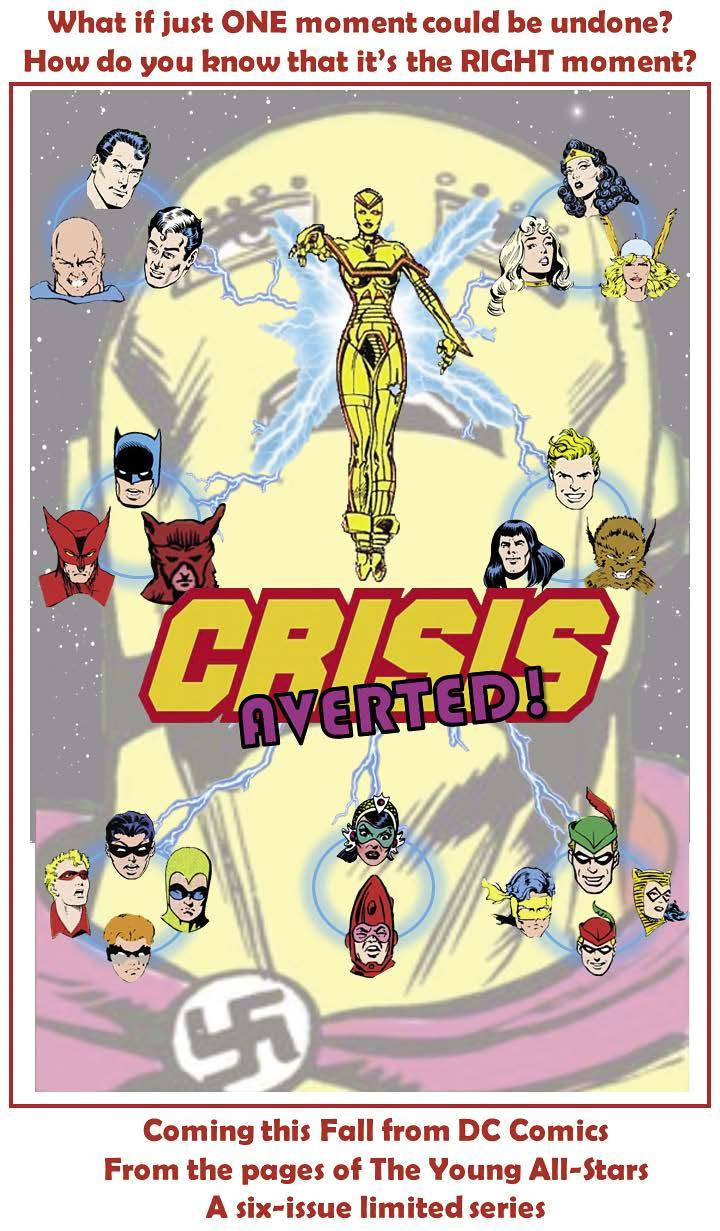
Then Infinity, Inc. appeared! Then the Seven Soldiers of Victory returned in Squadron! Then the Quality Comics characters joined! Watching them all interact in issue #31 blew my mind. The possibilities for amazing stories kept expanding.
As an adult, I’ll re-read these issues and wonder what other stories could have been told. My playwright brain would start to craft scenarios and plot points. What if Uncle Sam had more obscure Quality Comics heroes join the Freedom Fighters? What if the Golden Age Batman formed an Earth-Two version of The Outsiders? I started imagining what the covers would look like, what would inspire another fan to grab the issue from their magazine rack. What would excite a fellow Earth-Two fan?
I like to take familiar, iconic covers and transform them, reimagined for new Golden Age adventures that I wish I could read. These Young All-Stars covers are my answer to the question: “How could Superman, Wonder Woman, Batman, Robin, Aquaman, Green Arrow, and Speedy be brought back into the Golden Age continuity?” Having them defend their YAS homage characters against their Axis Amerika doppelgängers seemed too much fun to resist. It’s three interpretations of the same character (or characters of that same “energy”) in one place! Who doesn’t love a triumphant return?
I love sharing them in the various Justice Society of America fan groups on Facebook, where fellow fans ask who a character is or delight in identifying my source art or propose an idea of their own for a future cover. And it always comes back to the same sentiment:
We, the fans, love these Golden Age All-Stars and we miss them and we want more. PART FIVE 43 TM
AVERTED!
Just Imagine! JBL even composed his own “house ad” for his concept of The Young All-Stars: Crisis Averted series! [Heroes & villains TM & © DC Comics.]
Synopsis For Overall Series
Baron Blitzkrieg hatches a plan to alter the past to win the war. He sends Kung and Sumo back to the Perisphere headquarters of the All-Star Squadron. Their mission: to retrieve any and all discarded pieces of the Mekanique robot, cast off when Robotman redesigned her. Before they can rendezvous with the Baron, they are intercepted by Axis Amerika. The Great-Horned Owl uses the stolen future tech to prevent the death of his son, Fledermaus.
And, though he successfully restores his son to life, The Great-Horned Owl also unleashes an energy wave that somewhat restores Earth-Two. The Golden Age characters of Quality Comics and Charlton Comics remain in this Golden age timeline, as do the Young All-Stars and Axis Amerika. But the previously lost Golden Age heroes return as well...
The Young All-Stars: Crisis Averted #1 (of 6):
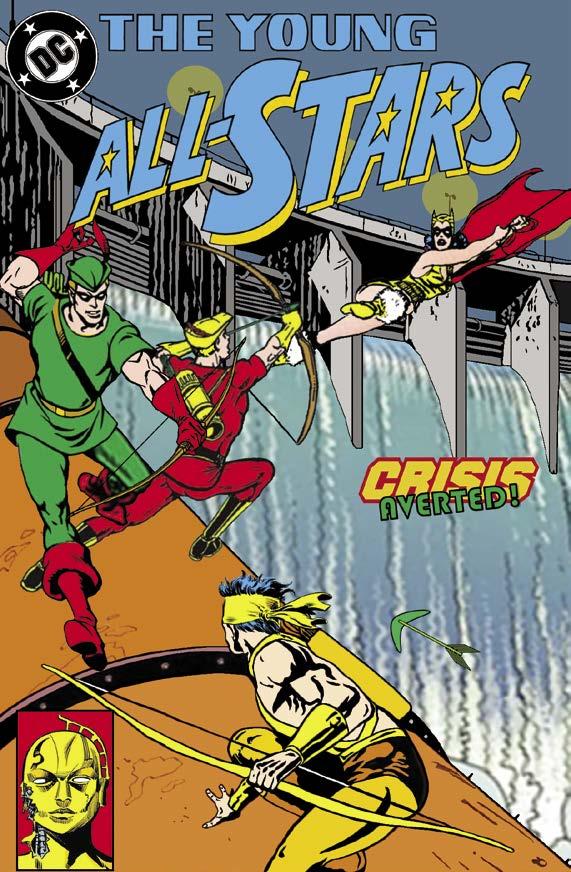

Superman returns to help “Iron” Munro defeat Übermensch! But lurking in the background is the Golden Age Lex Luthor. It’s not just the heroes who are back... [Homage to cover of Action Comics #584 by John Byrne & Dick Giordano.]
The Young All-Stars: Crisis Averted #2 (of 6):
Arrows aplenty as Green Arrow and Speedy take aim at Usil the Sun Archer and The Tigress! [Homage to cover of Green Arrow (Vol. 2) #98 by Rodolfo Damaggio.]
44 One Fan’s Response To The End Of Earth-Two
by John Joshua
INTRODUCTION: As John Joshua knows (because I told him), his wonderful project of commissioning “faux covers” of “my” DC Comics series All-Star Squadron beyond the 67 issues (plus three Annuals) that were published between 1981 and ’87 is one I can and do applaud—even though, if he (or anyone else) were actually producing such a continuation for DC, I would never so much as pick up a copy off the racks, due to my unequivocal hostility to the notion of anyone except myself continuing the All-Star Squadron, Young All-Stars, or Infinity, Inc. series while I’m still alive. (Just keep your shirts on, guys… all things come to those who wait.) Yet, as an exercise in extreme fan creativity, I’ve been the covers series’ biggest booster, determined if possible to eventually print all of the new covers in the pages of Alter Ego—and there are now basically as many faux covers accounted for by John and his enthusiastic cronies as there were in the original series! So here we go again, with more of those covers—some colored, some not—but first, a few comments from the High Commissioner himself….


A/E EDITOR’S
All In Color For This Time
The first “new” All-Star Squadron issue printed here (see next page) is #85, drawn by Craig Cermak, adapted from the cover of Avengers #72, and bringing back Deathbolt to attack the team in the Perisphere (I saw this as a follow-up to the story in Young All-Stars #15, which saw an earlier attempt by the villain to break into the team’s headquarters). Deathbolt is searching for the Hammer of Thor—which was not actually destroyed at the end of the Ultra-Humanite saga—on behalf of his mystery partner, revealed in #87 as the Lightning Master (from early “Superman” stories). Given their respective electrical powers, I’ve thought the two villains were a natural team ever since All-Star Squadron Annual #3. Over the course of the threeissue story, the Lightning Master threatens a nationwide power shutdown and attempts to use the Hammer of Thor to tap into the mystic lightning which powers The Marvel Family!
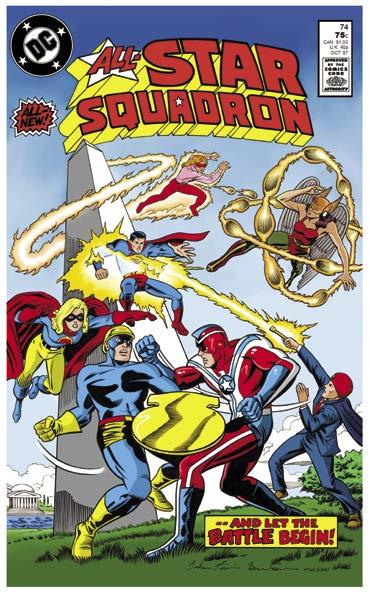
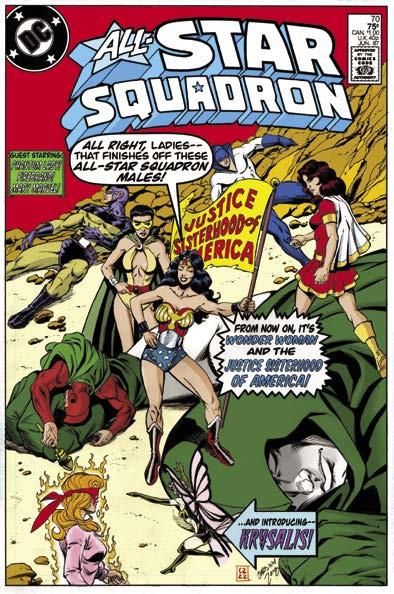
This cover highlights my love of the visual pun—replacing the Kree Captain Marvel with Freddy Freeman’s alter ego, Captain Marvel Jr., and substituting Air Wave for Yellowjacket, on the basis
of their similar earpieces. It also highlights one of the recurring issues I faced: Roy wrote a lot of comics (The Avengers, The Invaders) featuring Captain America, as well as the visually-similar US Agent in Avengers West Coast, and while DC’s Guardian is the obvious stand-in for either character, as here, I wanted to find alternatives for the star-spangled Avenger wherever possible. You can judge whether or not I was successful in doing so in some of the other covers in this article.
Next in line: the fifth Annual… art by Ian Richardson, adapted from the cover of The Invaders #2, concluding a story started in #88. While I’ve generally used pre-existing villains, whether from the Golden Age like Brain Wave, or later creations such as Baron Blitzkrieg, this was an opportunity to pick up on an idea Roy outlined in Alter Ego #9 (in a plot which eventually became his Heroic Publications comic Anthem) to feature an attack on the West Coast by either a Godzilla-like monster or a Shogun Warriors-esque giant robot. Anthem used a giant creature, so I opted for the gigantic
PART SIX 47 TM The ALL-STAR SQUADRON Covers That Never Were— Till Now! Part II – The Counter-Crisis Legend Continues From A/E #175!
Two “faux covers” that ran in black-&-white back in A/E #175, colored for this issue by Rich Seetoo: “#70” by Christopher Ivy, and “#74” by Brendon & Brian Fraim, as artful homages to the John Buscema/ Tom Palmer and Jack Kirby/Joe Sinnott covers of The Avengers #75 and The Invaders #6, respectively. [All characters TM & © DC Comics.]
Japanese robot—and asked Ian (and Mike Collins, who drew the cover for #88) to use an obscure Silver Age Flash villain, the Samuroid, here.
This issue also revealed my idea for the identity of The Dragon King (SPOILER ART: it’s Vandal Savage), though I later changed this in a story in #129-132 involving Dinosaur Island. I chose to use Batman as my “not The Guardian” substitute for Captain America here, since I thought a thrown batarang made an acceptable replacement for Cap’s shield—and, since Ian had expressed his surprise at how much he’d enjoyed drawing Johnny Thunder and his Thunderbolt on an earlier cover, they stand in for Bucky and The Human Torch respectively. Often the replacement heroes choose themselves, but in some cases I’m able to give the artists characters that they otherwise might not get the chance to draw.
Up next is issue #92, adapted from the cover to Legion of SuperHeroes #283 by artist Andrew Pepoy. This is one of the “Altered Egos” issues, in this case casting the spotlight (sorry) on The Ray. Andrew went above and beyond the call of duty on this one, reproducing the vintage logos from the original cover and meeting
my request for some obscure Squadron members, at extremely small size, in the “joining the team” upper right quadrant.
Again, this one features some visual punning: Phantom Lady, with her black-light projector, replacing Shadow Lass; The Flash, with his lightning-bolt symbol, in place of Lightning Lad; Starman stepping in for Star Boy; and Air Wave’s antenna earpieces mirroring the pointy-hair look which Timber Wolf sported at the time. Zatara also appears, since I couldn’t—and still can’t—identify the Legionnaire in his spot on the original cover; but by this point I was trying to include as many of the Squadron members as possible in these commissions. It took me until issue #119 (or #122, if you count Little Boy Blue) to find a slot for every character who appeared in the published series, discounting those who had been killed off, such as TNT and Uncle Sam’s original Freedom Fighters from issue #32. Even the dead heroes might get their chance, though: The Red Bee and TNT have both popped up, so there may yet be hope for Magno, Neon the Unknown, The Invisible Hood, and Red Torpedo.
#85: Art by Craig Cermak, colors by Rob Shalda; homage to Avengers #72 (Sal Buscema & Sam Grainger). Deathbolt invades the Perisphere to steal an artifact from the Squadron’s trophy room for his mystery partner. With The Spectre’s powers diminished after the events of Annual #4, can the team prevail?
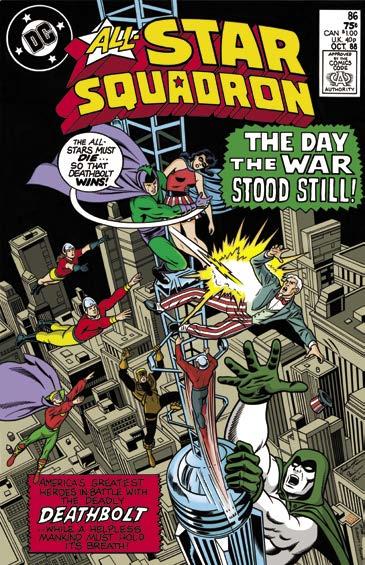
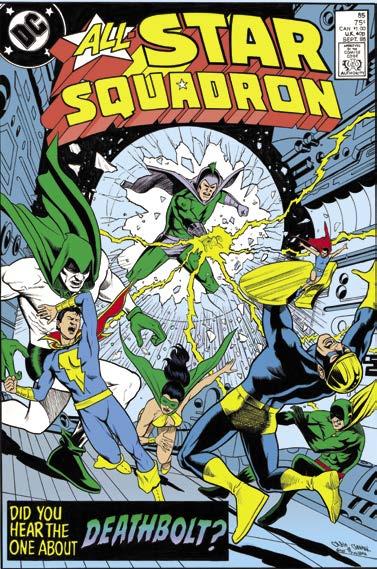
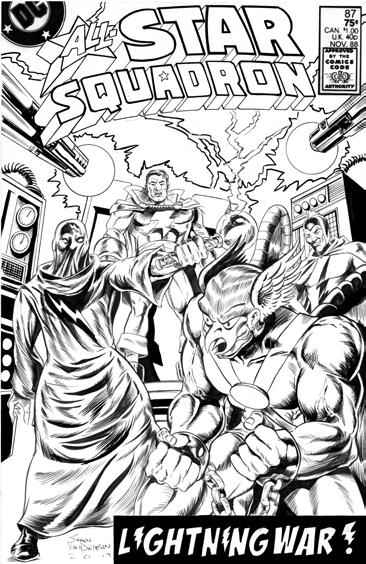
#86: Art by Brendon & Brian Fraim, colors by Rich Seetoo; homage to Avengers #76 (John Buscema & Tom Palmer). Deathbolt’s battle with the All-Stars continues—as his mystery partner threatens to paralyze the US war effort by shutting down electrical power across the country!
#87: Art by Shawn van Briesen; homage to What If?, Vol. 2, #38 (Paul Ryan). Deathbolt’s mystery partner revealed! The Lightning Master uses the Hammer of Thor to tap into the mystic lightning that powers The Marvel Family—and only Hawkman can stop him!
48 The Counter-Crisis Legend Continues!
Presenting—MORE Faux ALL-STAR SQUADRON Covers Continued from Alter Ego #175 (All Heroes & Villains on next 4 pages TM & © DC Comics) [
Continued on p. 51]
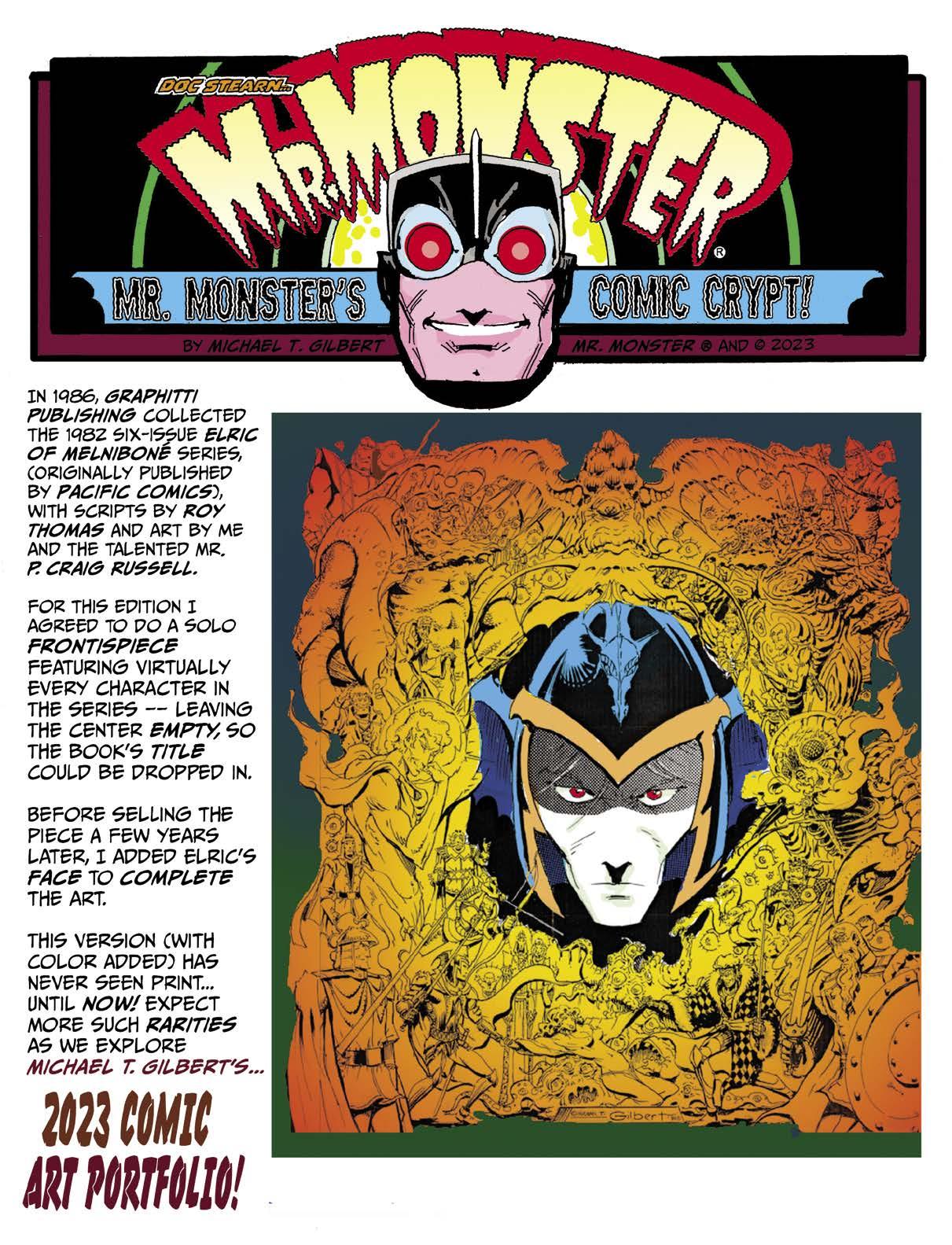
53
Michael T’s frontispiece for Graphitti’s 1986 Elric of Melniboné graphic novel collecting the six-issue comicbook series from Pacific Comics. Roy Thomas adapted the stories, with P. Craig Russell sharing the art chores. Newly colored for this printing. [Elric & other characters TM & © Michael Moorcock & Multiverse, Inc.]
Michael T . Gilbert’s 2023 Comic Art Portfolio!
by Michael T. Gilbert
When not otherwise engaged writing “Mr. Monster’s Comic Crypt!” for this magazine, or scripting or drawing comicbooks, your humble host occasionally takes on commissions. Once in a while I even do a comicbook pin-up or two just for fun.
I’ve run some of my other drawings in the past, and Roy suggested it might be time for another art display. So, without further ado…
Elric and Arioch!
In 1982, P. Craig Russell and I began drawing a six-issue Elric of Melniboné series for Pacific Comics, scripted by Roy Thomas. For those unfamiliar with Elric, he was a sword & sorcery anti-hero, written by celebrated fantasy author Michael Moorcock as something of an anti-Conan.
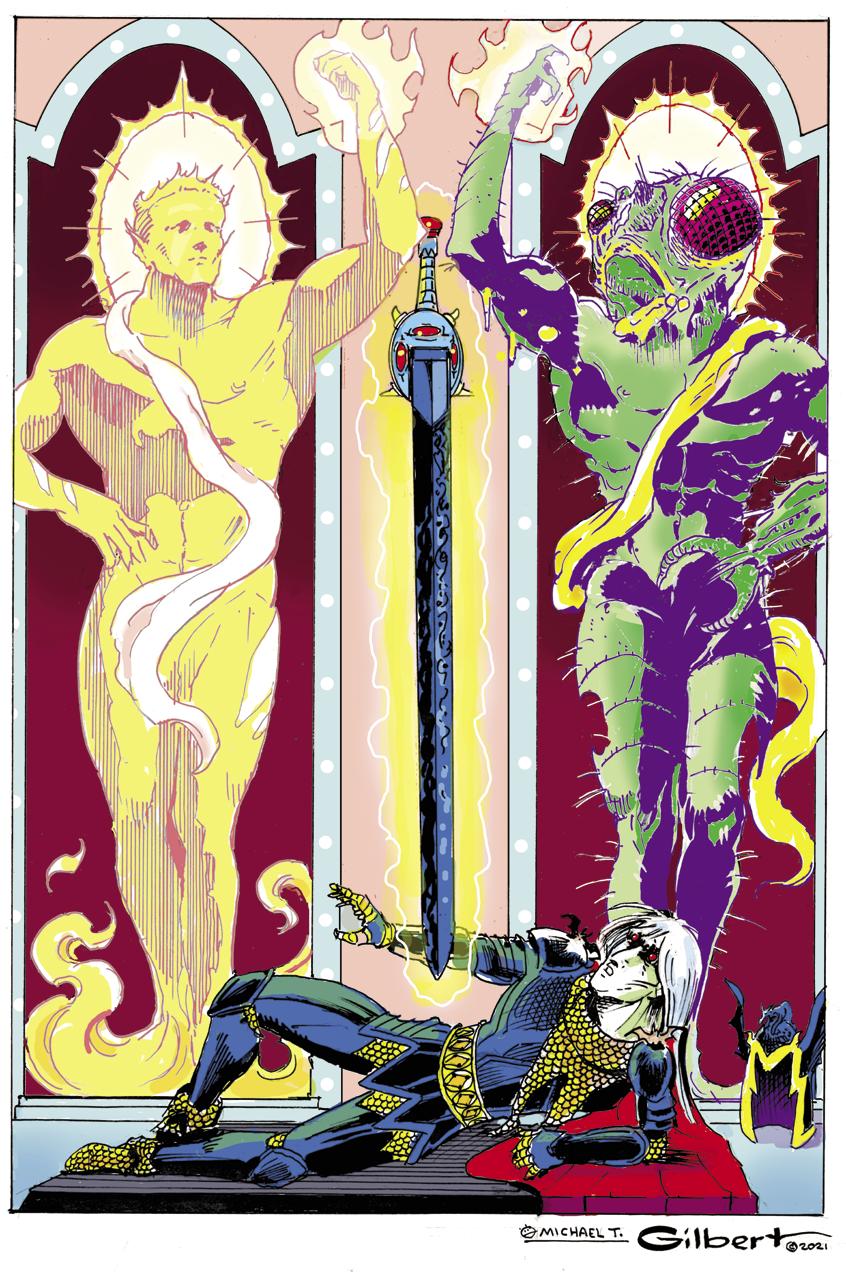
A weak, pale albino, Elric derived magical strength from his demonic sword. In time, Elric became totally dependent on his sword’s magic, not unlike a drug addict.
Elric’s greatest foe was the god Arioch, who could take the form of a beautiful boy, or a grotesque monster.
I was commissioned to do a picture of Elric, and the chap who hired me told me to draw anything I wanted. Cool! I thought it would be fun to show Elric, his demonic sword, and both aspects of Arioch. I tend to do my best work when I’m given the greatest latitude, and I was very happy with the results here. For this drawing, I attempted to channel my old Elric of Melniboné co-artist, P. Craig Russell.
The art was done in black & white, but I later colored it on computer for use here.
54 Mr. Monster’s Comic Crypt!
Double Trouble!
Michael T. draws two aspects of Elric’s foe, the evil god Arioch! [Characters © Michael Moorcock; art © Michael T. Gilbert.]

“Album of Comic-Book Life” – Concluded
The Second Half Of STANLEY KAUFFMANN’s Memories Of Fawcett Comics In The Early 1940s
Edited by P.C. Hamerlinck
INTRODUCTION: As laid out in detail in our previous issue, Stanley Kauffmann (1916-2013) was a famous and respected New York theatre and film critic for two-thirds of a century. After graduating in 1935 from New York University, he published his first novel, The King of Proxy Street, in 1941. Soon afterward, he spent nearly a year as an editor and staff writer for the B.W. Sangor art shop, which at the time produced material for the Pines/ Better/Nedor line of comicbooks In December of 1942 he was hired as a comics editor at Fawcett Publications, a large company whose comicbooks were only one of its divisions—though a very profitable one, due primarily to the burgeoning popularity of Captain Marvel, but with the rest of The Marvel Family, Bulletman, Spy Smasher, and others also raking in dimes, many of which came from US servicemen during World War II. Between December 1942 and January 1944, he served as the editor of three Fawcett titles: Captain Marvel Adventures (the company’s top-selling comic), Captain Midnight (a licensed version of the popular radio character), and Wow Comics (featuring Mary Marvel, Mr. Scarlet, et al.)
The Critic & The Captain
Alas, we never did manage to score a photo of Stanley Kauffmann in his mid-twenties, around the time he was editing for Fawcett Publications—so this 1971 one will have to do.
by Jerzy Kosinkski. By far the most important of the three Fawcett titles that Kauffmann edited from the turn of 1943 until very early ’44 was Captain Marvel Adventures, already well on its way to becoming for several years the top-selling comicbook on the planet. His issue #35 (May 1944) went on sale not long after he had traded in his Fawcett staff job for the freelance life of a novelist and, soon, theatrical and film critic. Art by C.C. Beck. [Shazam hero TM & © DC Comics.]
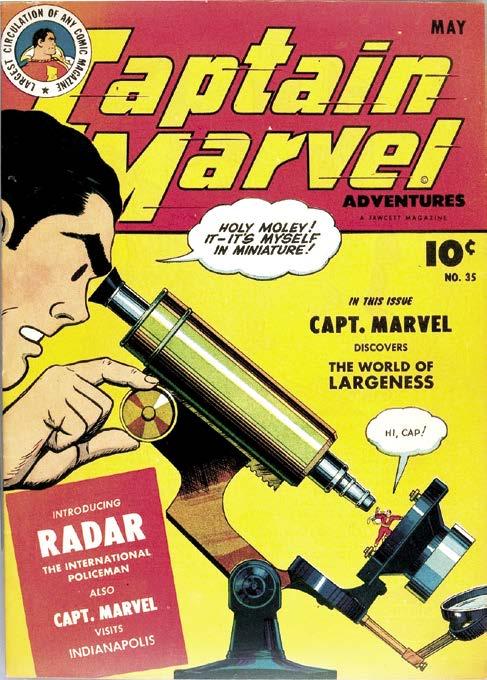

After leaving Fawcett, Kauffmann became a critic in the field of the dramatic arts. From 1958 to 2013 he was the film reviewer for The New Republic magazine. Besides publishing several collections of his reviews over the years, he also scribed two memoirs. Ironically, it was the latter of these, Albums of a Life (1980), that included a chapter titled “Album of Comic-Book Life,” in which he playfully discussed his relatively short time in the comics field (though he virtually ignored the months spent with the Sangor shop). He had received his “first draft-call” in April of ’41, receiving a “4-F” classification because of an earlier medical operation.
As noted last issue, Kauffmann used pseudonyms for Fawcett itself and for all its personnel, but nearly all of these have been easily identified since. Our only major alterations in the text have been to provide the real names of the protagonists, placing them between brackets after the use of the pseudonyms.
Fawcett itself was altered to “Tappan”; Kauffmann’s fellow comics editor Jane Magill became “Peg Molloy”; editor Henry Avelyn “Lynn” Perkins was “Colin James”; chief comics editor Rod Reed was referred to simply as “Hap”; editorial director Ralph Daigh became “Harold Knight”; Mechanix Illustrated editor Bill Williams mutated into “Virgil Burmeister”; comics heroes Captain Marvel and Captain Midnight were hidden behind the respective alter egos “Major Mighty” and “Nick Noonday”; and so on. The text is © 2007 Stanley Kauffmann, is reprinted with permission of Stanley Moss/Sheep Meadow Press, and was edited very slightly for this reprinting. —P.C. Hamerlinck.
There was still another reason why Peg Molloy [editor Jane Magill] liked me. We both loathed Colin James [editor Henry Avelyn “Lynn” Perkins]. Nobody cared much for Colin [Lynn]; although some (like Hap [chief editor Rod Reed]) pitied him
73
Photo
Part 3
a little. She and I loathed him.
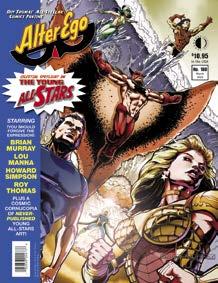
Colin [Lynn] was British, in his mid-twenties, and tall and fair, with an airy slow-motion manner and a pretty schoolboy face. His accent was British upper middle class; his family were civil servants. Why he was in the United States during the war, apparently able-bodied and certainly exempt, he never explained; rather, he went to some pains to be mysterious about it with a cozy smile. Despite this coziness he lived in some terror of the US draft, though he never explained that, either—why he should be subject to the American draft. He was always importantly busy with the file of folders he kept between bookends on his desk—none of the rest of us had anything like that. He was basically remote even when he chose to be friendly and was always at least patronizing. Usually he was arrogant.
I once suggested to Hap [Rod] that Colin [Lynn] might be some sort of British secret agent. Hap smiled wearily and said, “If that’s true, it’s going to be a long war.”
Colin [Lynn] was good at his work, which ensured his place, and sometimes he came close to conscious parody of his own hauteur, which was amusing. But Peg [Jane] and I loathed him because he was slimy with his superiors or with anyone who could help him, condescending or cruel with those over whom he had some power. Occasionally we were visited by film people— producers and actors—because Tappan [Fawcett] published [movie] fan magazines, and visitors to that department were taken on a grand tour of the factory.
Colin [Lynn] would always give film visitors the cordial British-gent treatment, would try to fasten on to the party, and often got himself invited to lunch or drinks. With the artists and writers who worked for him, he was silkily overbearing. With the messengers and such, he was pure sahib-with-the-gunbearers.
He had in fact been born in Brazil, where his father had been a minor upcountry colonial official who lived like a prince. I once asked Colin [Lynn] how he liked Brazil. He shook his head sadly. “The wrong color, you know? And so few of them speak decent English.” It was the sort of remark that almost made me like him, it was almost as if he were capable of self-caricature.
But besides the reasons I shared with Peg [Jane] for disliking him, I had a private reason. He adored his job. He edited three or four of the comic-books, the ones with a horror-emphasis, and he loved them. He would arrive in the morning with notes he had made during the night, he said, waking up from dreams about his magazines. His folders were full of projects and cross-references. He had long telephone conversations with artists and writers that were as complicated and rhetorical as if he were discussing foreign policy. (“But, my dear Alvin, let’s look at it from another aspect for a moment, shall we just? Suppose that the dam had burst before Baron Fujimiya fired his super-ray. That rather alters matters, doesn’t it? Give that some thought over the weekend, will you?”) I despised Colin’s [Lynn’s] total immersion in his work; it wasn’t
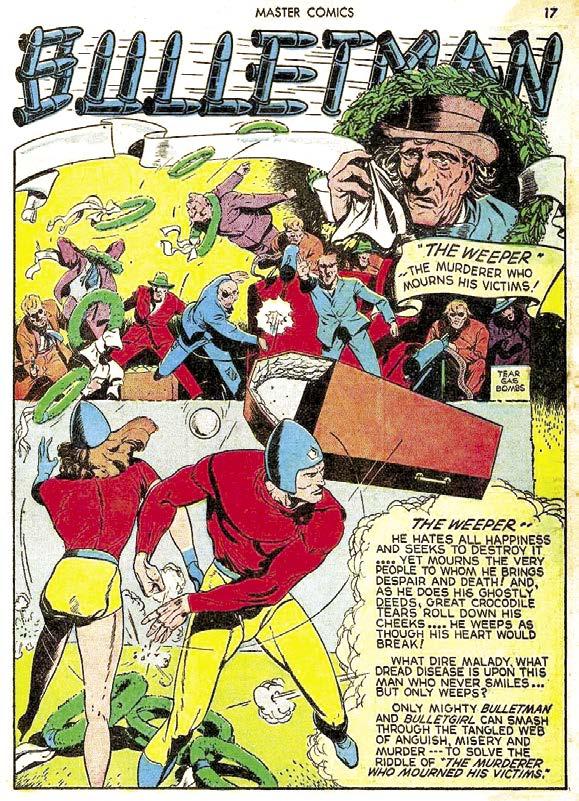
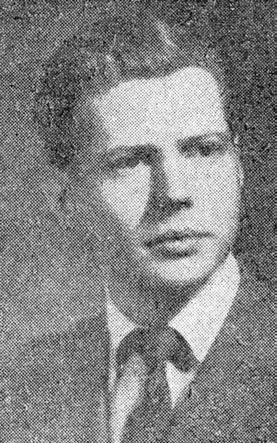
true of anyone else in the office, even those who were not leading double lives like mine. I was Anglophile enough to feel that he was desecrating a good English education by not taking the work with several grains of salt. And I may also have been a bit ambiguously uneasy that he was on to something, as, in terms of subsequent cultural developments, he certainly proved to be.
So he repelled and disturbed me, for modestly complex reasons, of which his whip-cracking was by far the worst. One day a black delivery boy brought him a sandwich from the drugstore on the ground floor. Colin [Lynn] made the boy wait while he opened the sandwich, examined the filling, telephoned downstairs and complained to the manager. Then he said to the boy, “Here’s the money for the sandwich since it’s here. But I certainly don’t intend to tip you for bringing me this garbage!” He waved the boy out.
This was only the latest of similar actions. Peg [Jane] and I
74 FCA [Fawcett Collectors of America]
Henry Aveline (“Lynn”) Perkins
IF YOU ENJOYED THIS PREVIEW, CLICK THE LINK TO ORDER THIS ISSUE IN PRINT OR DIGITAL FORMAT! ALTER EGO #180 THE YOUNG ALL-STARS—the late-1980s successor to ALLSTAR SQUADRON! Interviews with first artist BRIAN MURRAY and last artist LOU MANNA—surprising insights by writer/ co-creator ROY THOMAS—plus a panorama of never-seen Young All-Stars artwork! All-new cover by BRIAN MURRAY! Plus FCA (Fawcett Collectors of America), MICHAEL T. GIL BERT, and beyond! (84-page FULL-COLOR magazine) $10.95 (Digital Edition) $4.99 https://twomorrows.com/index.php?main_page=product_info&cPath=98_55&products_id=1664
Perkins had served from 1939-42 as associate editor of Weird Tales magazine before he (at least according to Wikipedia) gained entry to Fawcett’s comics line with his “Bulletman” story introducing The Weeper, a villain who is “convinced that life is sad and it’s criminal for people to be happy.” The latter made his debut in the “Bulletman” entry in Master Comics #23 (Feb. 1942), as drawn by the Jack Binder studio; he would reappear in several later stories. Perkins’ article on comicbook scripting for the April 1943 issue of the trade magazine Writers’ Journal was quoted and discussed in depth by Will Murray in the FCA section of A/E #157. [Bulletman & Bulletgirl TM & © DC Comics.]











































